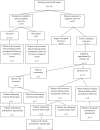Open Emergent Groin Hernia Repair: Anterior or Posterior Approach?
- PMID: 38314156
- PMCID: PMC10831659
- DOI: 10.3389/jaws.2022.10586
Open Emergent Groin Hernia Repair: Anterior or Posterior Approach?
Abstract
Introduction: The current literature has not yet provided a definitive conclusion on the best emergency groin hernia repair. The aim of this study was first to compare the short and long-term outcomes between open preperitoneal and anterior approach in emergency groin hernia repair and second to identify risk factors for postoperative complications, mortality, and recurrence. Materials and Methods: This retrospective cohort study included patients who underwent emergency groin hernia repair between January 2010 and December 2018. Short and long-term outcomes were analyzed comparing approach and repair techniques. The predictors of complications and mortality were investigated using multivariate logistic regression. Cox regression multivariate analysis were used to explore risk factors of recurrence. Results: A total of 316 patients met the inclusion criteria. The most widely used surgical techniques were open preperitoneal mesh repair (34%) and mesh plug (34%), followed by Lichtenstein (19%), plug and patch (7%) and tissue repair (6%). Open preperitoneal mesh repair was associated with lower rates of recurrence (p = 0.02) and associated laparotomies (p < 0.001). Complication and 90-day mortality rate was similar between the techniques. Multivariable analysis identified patients aged 75 years or older (OR, 2.08; 95% CI, 1.14-3.80; p = 0.016) and preoperative bowel obstruction (OR, 2.11; 95% CI, 1.20-3.70; p = 0.010) as risk factors for complications and Comprehensive Complication Index ≥26.2 as risk factor for 90-day mortality (OR, 44.76; 95% CI, 4.51-444.59; p = 0.01). Female gender was the only risk factor for recurrence. Conclusion: Open preperitoneal mesh repair may be superior to other techniques in the emergency setting, because it can avoid the morbidity of associated laparotomies, with a lower long-term recurrence rate.
Keywords: emergent groin hernia; incarcerated; open preperitoneal hernia repair; prosthetic mesh repair; strangulated.
Copyright © 2022 Rodrigues-Gonçalves, Verdaguer, Moratal, Blanco, Bravo-Salva, Pereira-Rodíguez and López-Cano.
Conflict of interest statement
ML-C has received honoraria for consultancy, lectures, support for travels and participation in review activities from BD-Bard, Medtronic and Gore. ML-C is the Editor-in-Chief of JAWS and declares that he did not participate in the management of the editorial process of the manuscript. The remaining authors declare that the research was conducted in the absence of any commercial or financial relationships that could be construed as a potential conflict of interest.
Figures
References
-
- Chihara N, Suzuki H, Sukegawa M, Nakata R, Nomura T, Yoshida H. Is the Laparoscopic Approach Feasible for Reduction and Herniorrhaphy in Cases of Acutely Incarcerated/Strangulated Groin and Obturator Hernia?: 17-Year Experience from Open to Laparoscopic Approach. J Laparoendoscopic Adv Surg Tech (2019) 29:631–7. 10.1089/lap.2018.0506 - DOI - PubMed
LinkOut - more resources
Full Text Sources
Miscellaneous




